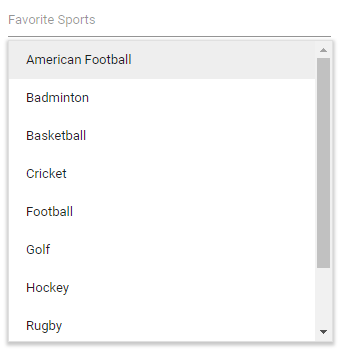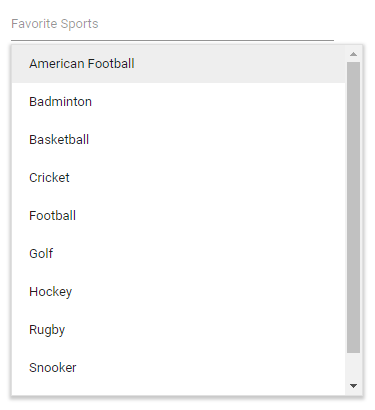Getting Started with Blazor MultiSelect DropDown Component
4 Nov 20259 minutes to read
This guide explains how to add the Blazor MultiSelect Dropdown component to a Blazor WebAssembly app using Visual Studio, Visual Studio Code, or the .NET CLI.
To get started quickly with the Blazor MultiSelect Dropdown in a Blazor WebAssembly app, see the GitHub sample.
Prerequisites
Create a new Blazor App in Visual Studio
Create a Blazor WebAssembly App using Visual Studio via Microsoft Templates or the Syncfusion® Blazor Extension. For detailed instructions, refer to this guide.
Install Syncfusion® Blazor DropDowns and Themes NuGet in the App
To add the Blazor MultiSelect Dropdown component, open the NuGet Package Manager in Visual Studio (Tools → NuGet Package Manager → Manage NuGet Packages for Solution), then install Syncfusion.Blazor.DropDowns and Syncfusion.Blazor.Themes. Alternatively, run the following Package Manager commands:
Install-Package Syncfusion.Blazor.DropDowns -Version 32.1.19
Install-Package Syncfusion.Blazor.Themes -Version 32.1.19NOTE
Syncfusion Blazor components are available on nuget.org. See the NuGet packages topic for the complete list of packages and component details.
Prerequisites
Create a new Blazor App in Visual Studio Code
Create a Blazor WebAssembly App using Visual Studio Code via Microsoft Templates or the Syncfusion® Blazor Extension. For detailed instructions, refer to this guide.
Alternatively, create a WebAssembly application by running the following command in the terminal(Ctrl+`).
dotnet new blazorwasm -o BlazorApp
cd BlazorAppInstall Syncfusion® Blazor DropDowns and Themes NuGet in the App
- Press Ctrl+` to open the integrated terminal in Visual Studio Code.
- Ensure the working directory contains the project
.csproj. - Run the following commands to install Syncfusion.Blazor.DropDowns and Syncfusion.Blazor.Themes, then restore packages.
dotnet add package Syncfusion.Blazor.DropDowns -v 32.1.19
dotnet add package Syncfusion.Blazor.Themes -v 32.1.19
dotnet restoreNOTE
Syncfusion Blazor components are available on nuget.org. See the NuGet packages topic for the complete list of packages and component details.
Prerequisites
Install the latest .NET SDK. To verify the installed version, run the following command:
dotnet --versionCreate a Blazor WebAssembly App using .NET CLI
Run the following commands to create a new Blazor WebAssembly app:
dotnet new blazorwasm -o BlazorApp
cd BlazorAppThis command creates a new Blazor WebAssembly app in a directory named BlazorApp. See Create a Blazor app and dotnet new CLI command for more details.
Install Syncfusion® Blazor DropDowns and Themes NuGet in the App
Install the Blazor MultiSelect Dropdown component using the following commands to add Syncfusion.Blazor.DropDowns and Syncfusion.Blazor.Themes. See Install and manage packages using the dotnet CLI for more details.
dotnet add package Syncfusion.Blazor.DropDowns -Version 32.1.19
dotnet add package Syncfusion.Blazor.Themes -Version 32.1.19
dotnet restoreNOTE
Syncfusion Blazor components are available on nuget.org. See the NuGet packages topic for the complete list of packages and component details.
Add Import Namespaces
Open the ~/_Imports.razor file and import the Syncfusion.Blazor and Syncfusion.Blazor.DropDowns namespaces.
@using Syncfusion.Blazor
@using Syncfusion.Blazor.DropDownsRegister Syncfusion® Blazor Service
Register the Syncfusion® Blazor Service in the ~/Program.cs file of your Blazor WebAssembly App.
using Microsoft.AspNetCore.Components.Web;
using Microsoft.AspNetCore.Components.WebAssembly.Hosting;
using Syncfusion.Blazor;
var builder = WebAssemblyHostBuilder.CreateDefault(args);
builder.RootComponents.Add<App>("#app");
builder.RootComponents.Add<HeadOutlet>("head::after");
builder.Services.AddScoped(sp => new HttpClient { BaseAddress = new Uri(builder.HostEnvironment.BaseAddress) });
builder.Services.AddSyncfusionBlazor();
await builder.Build().RunAsync();
....Add stylesheet and script resources
The theme stylesheet and script can be accessed from NuGet through Static Web Assets. Include the stylesheet and script references in the <head> section of the ~/index.html.
<head>
....
<link href="_content/Syncfusion.Blazor.Themes/bootstrap5.css" rel="stylesheet" />
<script src="_content/Syncfusion.Blazor.Core/scripts/syncfusion-blazor.min.js" type="text/javascript"></script>
//Blazor MultiSelect DropDown Component script reference.
<!-- <script src="_content/Syncfusion.Blazor.DropDowns/scripts/sf-multiselect.min.js" type="text/javascript"></script> -->
</head>NOTE
Check out the Blazor Themes topic to discover various methods (Static Web Assets, CDN, and CRG) for referencing themes in your Blazor application. Also, check out the Adding Script Reference topic to learn different approaches for adding script references in your Blazor application.
Add Blazor MultiSelect component
Add the Syncfusion® Blazor MultiSelect DropDown component in the ~/Pages/Index.razor.
<SfMultiSelect TValue="string[]" TItem="string" Placeholder='First Name'></SfMultiSelect>- Press Ctrl+F5 (Windows) or ⌘+F5 (macOS) to launch the application. This will render the Syncfusion® Blazor MultiSelect DropDown component in your default web browser.

Binding data source
After initialization, populate the MultiSelect using the DataSource property. In the following example, a list of objects is bound to the component, and TItem specifies the data type. Display and value fields are mapped via MultiSelectFieldSettings.
<SfMultiSelect TValue="string[]" TItem="Games" Placeholder="Favorite Sports" DataSource="@LocalData">
<MultiSelectFieldSettings Text="Text" Value="ID"></MultiSelectFieldSettings>
</SfMultiSelect>
@code {
public class Games
{
public string ID { get; set; }
public string Text { get; set; }
}
List<Games> LocalData = new List<Games> {
new Games() { ID= "Game1", Text= "American Football" },
new Games() { ID= "Game2", Text= "Badminton" },
new Games() { ID= "Game3", Text= "Basketball" },
new Games() { ID= "Game4", Text= "Cricket" },
new Games() { ID= "Game5", Text= "Football" },
new Games() { ID= "Game6", Text= "Golf" },
new Games() { ID= "Game7", Text= "Hockey" },
new Games() { ID= "Game8", Text= "Rugby"},
new Games() { ID= "Game9", Text= "Snooker" },
new Games() { ID= "Game10", Text= "Tennis"},
};
}
Configure the popup list
By default, the popup list width automatically adjusts to the MultiSelect input width, and the height auto-adjusts to the number of items.
Customize the popup size by setting PopupHeight and PopupWidth.
<SfMultiSelect TValue="string[]" TItem="Games" Placeholder="Favorite Sports" PopupHeight="350px" PopupWidth="350px" DataSource="@LocalData">
<MultiSelectFieldSettings Text="Text" Value="ID"></MultiSelectFieldSettings>
</SfMultiSelect>
Get selected value
Get the selected value of the MultiSelect component in the ValueChange event using the ChangeEventArgs.Value property.
@using Syncfusion.Blazor.DropDowns
<SfMultiSelect TValue="string[]" TItem="Games" Placeholder="Select a game" DataSource="@LocalData">
<MultiSelectFieldSettings Value="Text" Text="Text"></MultiSelectFieldSettings>
<MultiSelectEvents TValue="string[]" TItem="Games" ValueChange="OnValueChange"></MultiSelectEvents>
</SfMultiSelect>
@code {
public class Games
{
public string ID { get; set; }
public string Text { get; set; }
}
List<Games> LocalData = new List<Games> {
new Games() { ID= "Game1", Text= "American Football" },
new Games() { ID= "Game2", Text= "Badminton" },
new Games() { ID= "Game3", Text= "Basketball" },
new Games() { ID= "Game4", Text= "Cricket" },
new Games() { ID= "Game5", Text= "Football" },
new Games() { ID= "Game6", Text= "Golf" },
new Games() { ID= "Game7", Text= "Hockey" },
new Games() { ID= "Game8", Text= "Rugby"},
new Games() { ID= "Game9", Text= "Snooker" },
new Games() { ID= "Game10", Text= "Tennis"},
};
public void OnValueChange(MultiSelectChangeEventArgs<string[]> args)
{
Console.WriteLine("The MultiSelect Value is: ", args.Value);
}
}